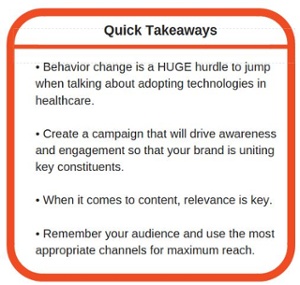
My colleague Michele Frost (VP of PANdigital) and I recently had the pleasure of keynoting the Zipnosis Customer Summit 2018 in Minneapolis. One of PAN’s newer digital health clients, Zipnosis is a virtual care software company that sells its platform into hospitals and health systems.
A hot topic on the minds of the executives, clinicians and IT constituents within these provider organizations is marketing. With the competition to attract and retain today’s discerning patients at an all-time high and given the abundance of information and resources at patients’ disposal to make more educated decisions about their health care and the delivery of that care — providers are looking to break through the noise to reach and engage patients while also promoting the innovations they can offer.
Rooted in this challenge is the fact that investment in today’s technological innovations need to be demonstrated in terms of financial ROI and quality of care. The question in the minds of providers, particularly those at the Zipnosis Summit, is: How do I maximize my investment in technology through marketing? Specifically, when it comes to disruptive technologies, how can they facilitate, accelerate and sustain adoption?
 We heard from many summit attendees that they either don’t have time or resources for marketing. If they do some marketing, it tends to be a one-off campaign vs. integrated with other efforts. While Michele and I made it all sound relatively easy, it is important to understand that, in many instances, behavior change is a HUGE hurdle to jump when talking about adopting technologies in healthcare. People don’t like change. They fear it. Which leads to low adoption.
We heard from many summit attendees that they either don’t have time or resources for marketing. If they do some marketing, it tends to be a one-off campaign vs. integrated with other efforts. While Michele and I made it all sound relatively easy, it is important to understand that, in many instances, behavior change is a HUGE hurdle to jump when talking about adopting technologies in healthcare. People don’t like change. They fear it. Which leads to low adoption.
The influx of technologies in healthcare over the past several years is causing physicians to throw up their arms in disgust. How could their platform stand out, let alone stand a chance in this type of environment? Michele and I had some answers and food for thought for the standing-room-only crowd to more effectively (and efficiently) market their disruptive technology for their benefit:
1. Unite Key Constituents
Creating awareness, increasing engagement and driving adoption starts with a campaign that can unite core constituents and give people good reason to buy in. For example, “Until Every Child is Well,” used by Boston Children’s Hospital. The campaign theme is tied directly to the mission, vision, value prop, business objectives and/or core messaging of the health system or hospital.
2. Cultivate Early Adopters into Advocates
As the campaign gains momentum internally, look for those who are early adopters and start to cultivate them into advocates. These advocates are often comfortable with technology and are strong communicators who can help amplify your message. They also consider being first as part of their personal brand and are motivated by the spotlight. Cultivate and nurture them—they will help immensely add third-party credibility and validation.
3. Study your Audience
Who are you targeting? Campaigns shouldn’t be one size fits all. Spend time understanding what makes your audience(s) tick—demographics, needs, buying behavior, engagement preferences. Once you have that insight, don’t just “set ’em and forget ’em.” Regularly look at data and refresh as necessary to gather the most up-to-date insights. Be sure to share across your organization and with other departments, including PR, HR/internal communications, sales and executives.
4. Provide Value with Content
What are you saying to them? According to PAN’s 2018 Content Fitness Report, 63 percent of healthcare marketers are creating content without a documented strategy or means of defining success. That’s not good.
Keep in mind that when it comes to content, relevance is critical. Connect your content to overarching themes that anchor the mission of your organization. Look for opportunities to consider timing; seasonal, industry, thematic. For example, cold and flu season is a great time to market to constituents about the value of a virtual care platform!
Remember your audience and use the most appropriate channels for maximum reach, frequency and engagement. Don’t just think about the written word; content comes in many forms—visual, audio, video, written. Lastly, for marketers who feel marketing is too time and resource intensive, you don’t have to re-create the wheel. Review existing assets and repurpose as appropriate.
5. Consider your Marketing Channels
Expose your content and determine which channels you are using to reach your audience. Implement a strategic mix of information that gives:
A) Value to your audience
B) Insightful information about your company (while keeping your brand’s voice and tone in mind at all times)
Be creative and visual.
Social media is viewed as the second-most effective digital marketing tactic for customer retention purposes, behind only email, according to PAN’s Content Fitness Report. In fact, 77 percent of buyers and customers prefer email marketing for communication. But, don’t forget to blog. According to our research, 45 percent of marketers say blogging is their #1 most important content strategy and companies and marketers that prioritize publishing regularly to a blog are 13x more likely to enjoy positive ROI.
 6. Utilize Integrated Measurement and Analytics
6. Utilize Integrated Measurement and Analytics
Last but not least, none of the above advice is worth anything unless you have the right measurement framework and metrics in place.
Here are a few ideas we shared at the Summit:
- Translate your financial model for supporting investments into timebound KPIs
- Develop a dashboard to track progress against KPIs and share it monthly
- Include soft metrics – care, quality, value – and share them ad hoc or monthly (at minimum)
- Communicate regularly with influencers and advocates
As you think about what your organization is doing (or not doing) from a marketing standpoint to drive patient engagement and promote your disruptive technologies that benefit patients and practitioners alike, check out our PAN reference library for additional advice and counsel or feel free to contact us. We work every day with brands that regularly interface with providers, health plans, employers and health technology vendors with demonstrable results. Let us show you how we can help your brand make an impact.


 6. Utilize Integrated Measurement and Analytics
6. Utilize Integrated Measurement and Analytics